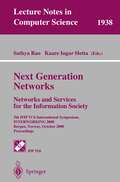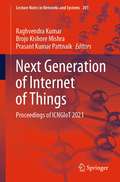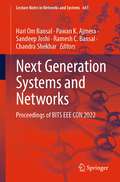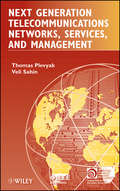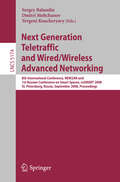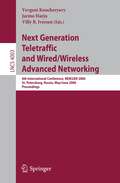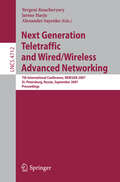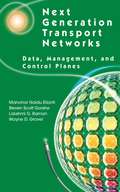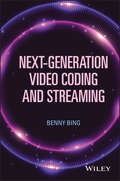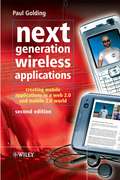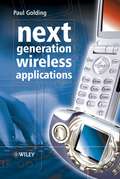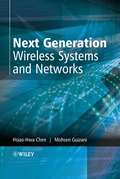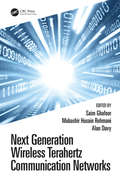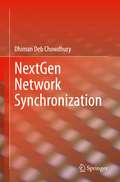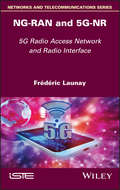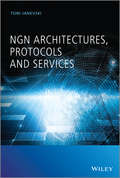- Table View
- List View
Next Generation Networks. Networks and Services for the Information Society: 5th IFIP TC6 International Symposium, INTERWORKING 2000, Bergen, Norway, October 3-6, 2000 Proceedings (Lecture Notes in Computer Science #1938)
by Sathya Rao Kaare I. SlettaAcknowledgements This Volume could not exist without the contributors of its papers. We would like to thank them on behalf of the Symposium organisers, for their support in making this a very successful conference. The editors would also like to thank all reviewers for their help in selecting quality papers. Organising such international events is not easy without the support of sponsors. We would like to thank TELENOR, which was very generous in accepting to host this conference under its Patronage. Our sincere thanks also go to all industrial sponsors and to the members and staff of the European Commission, who provided support of various kinds. In particular we would like to thank Dr. Paulo de Sousa of the European Commission, who helped us integrating the NGN concertation activity into the conference, and Ms. May Krosby of Telenor, who took care of the Secretariat. Last but not least, our sincere thanks to committee members who provided timely help in realising this conference and to our publishers Springer-Verlag for bringing out an excellent volume in time for the conference.
Next Generation of Internet of Things: Proceedings of ICNGIoT 2021 (Lecture Notes in Networks and Systems #201)
by Raghvendra Kumar Brojo Kishore Mishra Prasant Kumar PattnaikThis book includes selected papers from the International Conference on Next Generation of Internet of Things (ICNGIoT 2021), organized by the Department of Computer Science and Engineering, School of Engineering, GIET University, Gunupur, Odisha, India, during 5–6 February 2021. The book covers topics such as IoT network design and architecture, IoT network virtualization, IoT sensors, privacy and security for IoT, SMART environment, social networks, data science and data analytics, cognitive intelligence and augmented intelligence, and case studies and applications.
Next Generation Systems and Networks: Proceedings of BITS EEE CON 2022 (Lecture Notes in Networks and Systems #641)
by Hari Om Bansal Pawan K. Ajmera Sandeep Joshi Ramesh C. Bansal Chandra ShekharThe book is a collection of high-quality research papers presented at International Conference on Next Generation Systems and Networks (BITS EEE CON 2022), held at Birla Institute of Technology & Science, Pilani, Rajasthan, India, during November 4–5, 2022. This book provides reliable and efficient design solutions for the next-generation networks and systems. The book covers research areas in energy, power and control; communication and signal processing; and electronics and nanotechnology.
Next Generation Telecommunications Networks, Services, and Management (IEEE Press Series on Networks and Service Management #15)
by Thomas Plevyak Veli SahinAn unprecedented look into the present and future of next generation networks, services, and management in the telecommunications industry The telecommunications industry has advanced in rapid, significant, and unpredictable ways into the twenty-first century. Next Generation Telecommunications Networks, Services, and Management guides the global industry and academia even further by providing an in-depth look at current and developing trends, as well as examining the complex issues of developing, introducing, and managing cutting-edge telecommunications technologies. This is an orchestrated set of original chapters written expressly for this book by topic experts from around the globe. It addresses next generation technologies and architectures, with the focus on networks, services, and management. Key topics include: Opportunities and challenges of next generation telecommunications networks, services, and management Tri/Quad Play and IP-based networks and services Fault, Configuration, Accounting, Performance, and Security (FCAPS) requirements Convergence and an important convergence vehicle, IP Multimedia Subsystem (IMS) Next generation operations and network management architecture Ad hoc wireless and sensor networks and their management Next generation operations and network management standards from a strategic perspective A defining look at the future in this field This book will serve as a contemporary reference for the growing global community of telecommunication and information professionals in industry, government, and academia. It will be important to faculty and graduate students of telecommunications as a graduate textbook.
Next Generation Telecommunications Networks, Services, and Management (IEEE Press Series on Networks and Service Management #15)
by Thomas Plevyak Veli SahinAn unprecedented look into the present and future of next generation networks, services, and management in the telecommunications industry The telecommunications industry has advanced in rapid, significant, and unpredictable ways into the twenty-first century. Next Generation Telecommunications Networks, Services, and Management guides the global industry and academia even further by providing an in-depth look at current and developing trends, as well as examining the complex issues of developing, introducing, and managing cutting-edge telecommunications technologies. This is an orchestrated set of original chapters written expressly for this book by topic experts from around the globe. It addresses next generation technologies and architectures, with the focus on networks, services, and management. Key topics include: Opportunities and challenges of next generation telecommunications networks, services, and management Tri/Quad Play and IP-based networks and services Fault, Configuration, Accounting, Performance, and Security (FCAPS) requirements Convergence and an important convergence vehicle, IP Multimedia Subsystem (IMS) Next generation operations and network management architecture Ad hoc wireless and sensor networks and their management Next generation operations and network management standards from a strategic perspective A defining look at the future in this field This book will serve as a contemporary reference for the growing global community of telecommunication and information professionals in industry, government, and academia. It will be important to faculty and graduate students of telecommunications as a graduate textbook.
Next Generation Teletraffic and Wired/Wireless Advanced Networking: 8th International Conference, NEW2AN 2008 and 1st Russian Conference on Smart Spaces, ruSMART, St. Petersburg, Russia, September 3-5, 2008, Proceedings (Lecture Notes in Computer Science #5174)
by Sergey Balandin Dmitri Moltchanov Yevgeni KoucheryavyThis book constitutes the refereed proceedings of the 8th International Conference on Next Generation Teletraffic and Wired/Wireless Advanced Networking, NEW2AN 2008, held in St. Petersburg, Russia in September 3-5, 2008 in conjunction with the First ruSMART 2008. The 21 revised full papers presented were carefully reviewed and selected from a total of 60 submissions. The NEW2AN papers are organized in topical sections on wireless networks, multi-hop wireless networks, cross-layer design, teletraffic theory, multimedia communications, heterogeneous networks, network security. The ruSMART papers start with three keynote talks followed by seven articles on Smart Spaces.
Next Generation Teletraffic and Wired/Wireless Advanced Networking: 6th International Conference, NEW2AN 2006, St. Petersburg, Russia, May 29-June 2, 2006, Proceedings (Lecture Notes in Computer Science #4003)
by Yevgeni Koucheryavy Jarmo Harju Villy B. IversenThis book constitutes the refereed proceedings of the 6th International Conference on Next Generation Teletraffic and Wired/Wireless Advanced Networking, NEW2AN 2006, held in St. Petersburg, Russia in May/June 2006. The book includes 49 revised full papers presented together with 2 keynote talks. The papers are organized in topical sections on teletraffic, traffic characterization and modeling, 3G/UMTS, sensor networks, WLAN, QoS, MANETs, lower layer techniques, PAN technologies, and TCP.
Next Generation Teletraffic and Wired/Wireless Advanced Networking: 7th International Conference, NEW2AN 2007, St. Petersburg, Russia, September 10-14, 2007, Proceedings (Lecture Notes in Computer Science #4712)
by Yevgeni Koucheryavy Jarmo Harju Alexander SayenkoThis book constitutes the refereed proceedings of the 7th International Conference on Next Generation Teletraffic and Wired/Wireless Advanced Networking, NEW2AN 2007. The 39 revised full papers presented were carefully reviewed and selected from a total of 113 submissions. The papers are organized in topical sections on teletraffic, traffic characterization and modeling, 3G/UMTS, sensor networks, WLAN, QoS, MANETs, lower layer techniques, PAN technologies, and TCP.
Next Generation Transport Networks: Data, Management, and Control Planes
by Manohar Naidu Ellanti Steven Scott Gorshe Lakshmi G. Raman Wayne D. GroverCovering past, present and future transport networks using three layered planes written by experts in the field. Targeted at both practitioners and academics as a single source to get an understanding of how transport networks are built and operated Explains technologies enabling the next generation transport networks
Next-Generation Video Coding and Streaming
by Benny BingReviews the new High Efficiency Video Coding (HEVC) standard and advancements in adaptive streaming technologies for use in broadband networks and the InternetThis book describes next-generation video coding and streaming technologies with a comparative assessment of the strengths and weaknesses. Specific emphasis is placed on the H.265/HEVC video coding standard and adaptive bit rate video streaming. In addition to evaluating the impact of different types of video content and powerful feature sets on HEVC coding efficiency, the text provides an in-depth study on the practical performance of popular adaptive streaming platforms and useful tips for streaming optimization. Readers will learn of new over-the-top (OTT) online TV advancements, the direction of the broadband telecommunications industry, and the latest developments that will help keep implementation costs down and maximize return on infrastructure investment. Reviews the emerging High Efficiency Video Coding (HEVC) standard and compares its coding performance with the MPEG-4 Advanced Video Coding (AVC) and MPEG-2 standards Provides invaluable insights into the intra and inter coding efficiencies of HEVC, such as the impact of hierarchical block partitioning and new prediction modes Evaluates the performance of the Apple and Microsoft adaptive streaming platforms and presents innovative techniques related to aggregate stream bandwidth prediction, duplicate chunk Includes end-of-chapter homework problems and access to instructor slides Next-Generation Video Coding and Streaming is written for students, researchers, and industry professionals working in the field of video communications.Benny Bing has worked in academia for over 20 years. He has published over 80 research papers and 12 books, and has 6 video patents licensed to industry. He has served as a technical editor for several IEEE journals and an IEEE Communications Society Distinguished lecturer. He also received the National Association of Broadcasters (NAB) Technology Innovation Award for demonstrations of advanced media technologies.
Next-Generation Video Coding and Streaming
by Benny BingReviews the new High Efficiency Video Coding (HEVC) standard and advancements in adaptive streaming technologies for use in broadband networks and the InternetThis book describes next-generation video coding and streaming technologies with a comparative assessment of the strengths and weaknesses. Specific emphasis is placed on the H.265/HEVC video coding standard and adaptive bit rate video streaming. In addition to evaluating the impact of different types of video content and powerful feature sets on HEVC coding efficiency, the text provides an in-depth study on the practical performance of popular adaptive streaming platforms and useful tips for streaming optimization. Readers will learn of new over-the-top (OTT) online TV advancements, the direction of the broadband telecommunications industry, and the latest developments that will help keep implementation costs down and maximize return on infrastructure investment. Reviews the emerging High Efficiency Video Coding (HEVC) standard and compares its coding performance with the MPEG-4 Advanced Video Coding (AVC) and MPEG-2 standards Provides invaluable insights into the intra and inter coding efficiencies of HEVC, such as the impact of hierarchical block partitioning and new prediction modes Evaluates the performance of the Apple and Microsoft adaptive streaming platforms and presents innovative techniques related to aggregate stream bandwidth prediction, duplicate chunk Includes end-of-chapter homework problems and access to instructor slides Next-Generation Video Coding and Streaming is written for students, researchers, and industry professionals working in the field of video communications.Benny Bing has worked in academia for over 20 years. He has published over 80 research papers and 12 books, and has 6 video patents licensed to industry. He has served as a technical editor for several IEEE journals and an IEEE Communications Society Distinguished lecturer. He also received the National Association of Broadcasters (NAB) Technology Innovation Award for demonstrations of advanced media technologies.
Next Generation Wireless Applications: Creating Mobile Applications in a Web 2.0 and Mobile 2.0 World
by Paul Golding"Cuts through the hype! Golding's compelling offers visionary, but practical insights. A "must have" reference treatment for all practitioners in the mobile innovation space." —Jag Minhas, Telefónica O2 Europe Second edition of this best-selling guide to Wireless Applications: fully revised, updated and with brand new material! In Next Generation Wireless Applications, Second Edition, the author establishes a picture of the entire mobile application ecosystem, and explains how it all fits together. This edition builds upon the successes of the first edition by offering an up-to-date holistic guide to mobile application development, including an assessment of the applicability of new mobile applications, and an exploration into the developments in a number of areas such as Web 2.0, 3G, Mobile TV, J2ME (Java 2 Micro Edition) and many more. Key features of this second edition include: New introductory chapters on trends in mobile application, and on becoming an Operator. Two new chapters on Mobile 2.0 and IMS and Mobilizing Media and TV. Extra material on convergence, Web 2.0, AJAX (Asynchronous JavaScript and XML), HSDPA (High Speed Downlink Packet Access) and MBMS (Multimedia Broadcast Multicast Service), WiMAX (Worldwide Interoperability for Microwave Access) and WiFi. Best practice on how to present to, sell to and work with operators. More insights, anecdotes and sidebars reflecting the author's extensive experience in the industry. Next Generation Wireless Applications will prove essential reading for professionals in mobile operator and mobile application developing companies, web developers, and developer community managers. Media companies, general managers, business analysts, students, business consultants, and Java developers will also find this book captivating. "If you want to understand the future of mobile applications and services, their potential impact and the growth opportunities this is the perfect starting point." —Martin Smith, Head of Content Innovation & Applications, T-Mobile
Next Generation Wireless Applications
by Paul GoldingIn this rapidly developing field, this book explains why the various technologies are needed and will guide the reader to a deeper understanding of their significance and benefits within the industry. Focussing on the wireless context will give the reader a better understanding of how to use the technologies specifically in the development of wireless applications. Uniquely, Next Generation Wireless Applications shows how the many and various technologies interoperate and can be used in combination to achieve useful results. The book also provides an authoritative view of the market opportunities for 3G enabling the reader to gauge the credibility and value of the many participants active in this market and helping the reader to detect and avoid risky business opportunities. Unique coverage of the state-of-the-art software development technologies appropriate in a wireless context Brings together software development expertise with an understanding of wireless issues Based on author’s extensive experience building wireless applications and training on the topic Describes both strengths and weaknesses of particular technologies, short-cuts and potential pit-falls Demonstrates how technologies fit together and may be used together to enhance functionality Dispells myths and demystifies technologies thanks to author’s extensive knowledge base and tried-and-tested presentation skills Numerous case studies (from Lucent, NTT DoCoMo and Vodafone) and anecdotes anchor the book in reality Covers SMS, MMS, LBS, billing issues, mobile information device profile specs (MIDP2.0), over-the-air-deployment mechanisms, service delivery platforms (SDP) and security.
Next Generation Wireless Systems and Networks
by Hsiao-Hwa Chen Mohsen GuizaniNext Generation Wireless Systems and Networks offers an expert view of cutting edge Beyond 3rd Generation (B3G) wireless applications. This self-contained reference combines the basics of wireless communications, such as 3G wireless standards, spread spectrum and CDMA systems, with a more advanced level research-oriented approach to B3G communications, eliminating the need to refer to other material. This book will provide readers with the most up-to-date technological developments in wireless communication systems/networks and introduces the major 3G standards, such as W-CDMA, CDMA2000 and TD-SCDMA. It also includes a focus on cognitive radio technology and 3GPP E-UTRA technology; areas which have not been well covered elsewhere. Covers many hot topics in the area of next generation wireless from the authors’ own research, including: Bluetooth, all-IP wireless networking, power-efficient and bandwidth-efficient air-link technologies, and multi-user signal processing in B3G wireless Clear, step-by-step progression throughout the book will provide the reader with a thorough grounding in the basic topics before moving on to more advanced material Addresses various important topics on wireless communication systems and networks that have emerged only very recently, such as Super-3G technology, 4G wireless, UWB, OFDMA and MIMO Includes a wealth of explanatory tables and illustrations This essential reference will prove invaluable to senior undergraduate and postgraduate students, academics and researchers. It will also be of interest to telecommunications engineers wishing to further their knowledge in this field.
Next Generation Wireless Terahertz Communication Networks
by Saim GhafoorThe rapid growth of the data traffic demands new ways to achieve high-speed wireless links. The backbone networks, data centers, mission-critical applications, as well as end-users sitting in office or home, all require ultra-high throughput and ultra-low latency wireless links. Sophisticated technological advancement and huge bandwidth are required to reduce the latency. Terahertz band, in this regard, has a huge potential to provide these high-capacity links where a user can download the file in a few seconds. To realize the high-capacity wireless links for future applications, in this book, different aspects of the Terahertz band wireless communication network are presented. This book highlights the Terahertz channel characteristics and modeling, antenna design and beamforming, device characterization, applications, and protocols. It also provides state-of-the-art knowledge on different communication aspects of Terahertz communication and techniques to realize the true potential of the Terahertz band for wireless communication.
Next Generation Wireless Terahertz Communication Networks
by Saim Ghafoor Mubashir Husain Rehmani Alan DavyThe rapid growth of the data traffic demands new ways to achieve high-speed wireless links. The backbone networks, data centers, mission-critical applications, as well as end-users sitting in office or home, all require ultra-high throughput and ultra-low latency wireless links. Sophisticated technological advancement and huge bandwidth are required to reduce the latency. Terahertz band, in this regard, has a huge potential to provide these high-capacity links where a user can download the file in a few seconds. To realize the high-capacity wireless links for future applications, in this book, different aspects of the Terahertz band wireless communication network are presented. This book highlights the Terahertz channel characteristics and modeling, antenna design and beamforming, device characterization, applications, and protocols. It also provides state-of-the-art knowledge on different communication aspects of Terahertz communication and techniques to realize the true potential of the Terahertz band for wireless communication.
Next Move, Best Move: Transitioning Into a Career You'll Love
by Kimberly B. CummingsAn expert guide for professionals seeking to understand how to navigate the world of work.Kimberly B. Cummings, author of Next Move, Best Move: Transitioning into a Career You'll Love, leaves no stone unturned with this thorough, expert guide for professionals seeking to understand how to navigate the world of work, from beginning to end, starting with uncovering personal and professional values in an effort to align their expertise and skills to roles and companies that will finally change the trajectory of their career and set them up to be leaders in the workforce.As a former career development adviser in some of the nation’s top universities and a diversity + inclusion professional in a Fortune 100 company, Cummings has recognized that people work for the sake of working without understanding how to leverage their unique gifts and position themselves for success. As a result, Next Move, Best Move: Transitioning into a Career You’ll Love shares transformational lessonsto ensure success and puts the ball back in your court. In Cummings’ highly acclaimed book, a specific, effective framework is unveiled to ensure each reader channels and utilizes their highest potential as they regain control and steer professional opportunities in their favor, gaining key information as to: Taking stock of their experiences to ensure strategic career moves Discovering how to cultivate and maintain fruitful relationships that support career growth Uncovering how to build a two-year career strategy to move you into future leadership positions Gaining a deeper look into personal and professional branding to ensure alignment with leadership capabilities and career goals Learning how to use their voice in the workplace to advocate for themselves Author, leadership expert, and entrepreneur, Kimberly B. Cummings, has been featured in Forbes, MONEY Magazine, The Wall Street Journal, CNBC, Fox 5, among many others, and is a proud graduate of Long Island University, earning a Bachelor of Science in business administration and Master of Science in counseling. Through Cummings’ professional experiences as a career development adviser in some of the nation’s top universities and a diversity + inclusion professional in a Fortune 100 company, her highly celebrated book works in tandem with her experiences and sought-after leadership development company, Manifest Yourself, which provides fail-proof solutions to companies looking to engage and retain their workforce. For more information, visit www.kimberlybcummings.com.
Next Move, Best Move: Transitioning Into a Career You'll Love
by Kimberly B. CummingsAn expert guide for professionals seeking to understand how to navigate the world of work.Kimberly B. Cummings, author of Next Move, Best Move: Transitioning into a Career You'll Love, leaves no stone unturned with this thorough, expert guide for professionals seeking to understand how to navigate the world of work, from beginning to end, starting with uncovering personal and professional values in an effort to align their expertise and skills to roles and companies that will finally change the trajectory of their career and set them up to be leaders in the workforce.As a former career development adviser in some of the nation’s top universities and a diversity + inclusion professional in a Fortune 100 company, Cummings has recognized that people work for the sake of working without understanding how to leverage their unique gifts and position themselves for success. As a result, Next Move, Best Move: Transitioning into a Career You’ll Love shares transformational lessonsto ensure success and puts the ball back in your court. In Cummings’ highly acclaimed book, a specific, effective framework is unveiled to ensure each reader channels and utilizes their highest potential as they regain control and steer professional opportunities in their favor, gaining key information as to: Taking stock of their experiences to ensure strategic career moves Discovering how to cultivate and maintain fruitful relationships that support career growth Uncovering how to build a two-year career strategy to move you into future leadership positions Gaining a deeper look into personal and professional branding to ensure alignment with leadership capabilities and career goals Learning how to use their voice in the workplace to advocate for themselves Author, leadership expert, and entrepreneur, Kimberly B. Cummings, has been featured in Forbes, MONEY Magazine, The Wall Street Journal, CNBC, Fox 5, among many others, and is a proud graduate of Long Island University, earning a Bachelor of Science in business administration and Master of Science in counseling. Through Cummings’ professional experiences as a career development adviser in some of the nation’s top universities and a diversity + inclusion professional in a Fortune 100 company, her highly celebrated book works in tandem with her experiences and sought-after leadership development company, Manifest Yourself, which provides fail-proof solutions to companies looking to engage and retain their workforce. For more information, visit www.kimberlybcummings.com.
NextGen Network Synchronization
by Dhiman Deb ChowdhuryThis book presents time synchronization and its essential role as a conduit of optimized networks and as one of the key imperatives of ubiquitous connectivity. The author discusses how, without proper time synchronization, many mission critical infrastructures such as 5G mobile networks, smart grids, data centres CATV, and industrial networks would render in serious performance issues and may be subject to catastrophic failure. The book provides a thorough understanding of time synchronization from fundamental concepts to the application of time synchronization in NextGen mission critical infrastructure. Readers will find information not only on designing the optimized products for mission critical infrastructure but also on building NextGen mission critical infrastructure.
Nexus Analysis: Discourse and the Emerging Internet
by Suzie Wong ScollonNexus Analysis presents an exciting theory by two of the leading names in discourse analysis and provides a practical guide to its application. The authors argue that discourse analysis can itself be a form of social action. If the discourse analyst is part of the nexus of practice under study, then the analysis can itself transform that nexus of practice. Focussing on their own involvement with and analysis of pioneering communication technologies in Alaska they identify moments of social importance in order to examine the links between social practice, culture and technology. Media are identified not only as means of expressing change but also as catalysts for change itself, with the power to transform the socio-cultural landscape. In this intellectually exciting yet accessible book, Ron Scollon and Suzie Wong Scollon present a working example of their theory in action and provide a personal snapshot of a key moment in the history of communication technology, as the Internet transformed Alaskan life.
Nexus Analysis: Discourse and the Emerging Internet
by Suzie Wong ScollonNexus Analysis presents an exciting theory by two of the leading names in discourse analysis and provides a practical guide to its application. The authors argue that discourse analysis can itself be a form of social action. If the discourse analyst is part of the nexus of practice under study, then the analysis can itself transform that nexus of practice. Focussing on their own involvement with and analysis of pioneering communication technologies in Alaska they identify moments of social importance in order to examine the links between social practice, culture and technology. Media are identified not only as means of expressing change but also as catalysts for change itself, with the power to transform the socio-cultural landscape. In this intellectually exciting yet accessible book, Ron Scollon and Suzie Wong Scollon present a working example of their theory in action and provide a personal snapshot of a key moment in the history of communication technology, as the Internet transformed Alaskan life.
NG-RAN and 5G-NR: 5G Radio Access Network and Radio Interface
by Frederic LaunayNG-RAN and 5G-NR describes the deployment of 5G NSA (non standalone 5G) and 5G-SA (standalone 5G). 5G-NSA deals with radio access entities. For the 5G-NSA mode, dual MR DC connectivity is based on radio measurements, allowing the master 4G base station MeNB to add or remove a secondary 5G node SgNB.This book describes the architecture of the NG radio access network and the 5G-NR radio interface according to the 3GPP (3rd Generation Partnership Project) specifications. The overall architecture of the NG-RAN, including the NG, Xn and F1 interfaces and their interaction with the radio interface, are also described. The 5G-NR physical layer is mainly connected by implementing antennas, which improves transmission capacity. 5G-SA deals with the 5G Core network.In the 5G-SA model, the mobile is attached to the 5G Core network through NG-RAN. The book explains radio procedure, from switching on a device to establishing a data connection, and how this connection is maintained even if mobility is involved for both 5G-SA and 5G-NSA deployment. NG-RAN and 5G-NR is devoted to the radio access network, but mobile registration, establishment procedures and re-establishment procedures are also explained.
NG-RAN and 5G-NR: 5G Radio Access Network and Radio Interface
by Frederic LaunayNG-RAN and 5G-NR describes the deployment of 5G NSA (non standalone 5G) and 5G-SA (standalone 5G). 5G-NSA deals with radio access entities. For the 5G-NSA mode, dual MR DC connectivity is based on radio measurements, allowing the master 4G base station MeNB to add or remove a secondary 5G node SgNB.This book describes the architecture of the NG radio access network and the 5G-NR radio interface according to the 3GPP (3rd Generation Partnership Project) specifications. The overall architecture of the NG-RAN, including the NG, Xn and F1 interfaces and their interaction with the radio interface, are also described. The 5G-NR physical layer is mainly connected by implementing antennas, which improves transmission capacity. 5G-SA deals with the 5G Core network.In the 5G-SA model, the mobile is attached to the 5G Core network through NG-RAN. The book explains radio procedure, from switching on a device to establishing a data connection, and how this connection is maintained even if mobility is involved for both 5G-SA and 5G-NSA deployment. NG-RAN and 5G-NR is devoted to the radio access network, but mobile registration, establishment procedures and re-establishment procedures are also explained.
NGN Architectures, Protocols and Services
by Toni JanevskiComprehensive coverage explaining the correlation and synergy between Next Generation Networks and the existing standardized technologies This book focuses on Next Generation Networks (NGN); in particular, on NGN architectures, protocols and services, including technologies, regulation and business aspects. NGN provides convergence between the traditional telecommunications and the Internet, and it is globally standardized by the ITU (International Telecommunication Union), where ITU is the United Nations specialized agency for Information and Communication Technologies – ICTs. The convergence towards the NGN is based on the Internet technologies, and the introductory chapters cover the Internet fundamentals of today, including architectures, protocols (IPv4, IPv6, TCP, DNS, etc.), Internet services (WWW, e-mail, BitTorrent, Skype, and more), as well as Internet governance. Further, the prerequisite for convergence of all ICT services over single network architectures is broadband access to the Internet. Hence, the book includes architectures of fixed broadband Internet access networks, such as DSL (Digital Subscriber Line) networks, cable networks, FTTH (Fiber To The Home), next generation passive and active optical networks, and metro Ethernet. It also covers network architectures for next generation (4G) mobile and wireless networks (LTE/LTE-Advanced, and Mobile WiMAX 2.0), then Fixed Mobile Convergence - FMC, next generation mobile services, as well as business and regulatory aspects for next generation mobile networks and services. Comprehensive coverage explaining the correlation and synergy between Next Generation Networks and the existing standardized technologies Focuses on Next Generation Networks (NGN) as defined by the ITU, including performance, service architectures and mechanisms, common IMS (IP Multimedia Subsystem), control and signalling protocols used in NGN, security approaches, identity management, NGN Service Overlay Networks, and NGN business models Examines the most important NGN services, including QoS-enabled VoIP, IPTV over NGN, web services in NGN, peer-to-peer services, Ubiquitous Sensor Network (USN) services, VPN services in NGN, Internet of things and web of things Includes the transition towards NGN from the PSTN (Public Switched Telephone Networks) and from the best-effort Internet via the same Internet access Explores advanced topics such as IPv6-based NGN, network virtualization, and future packet based networks, as well as business challenges and opportunities for the NGN evolved networks and services Essential reading for engineers and employees from regulatory bodies, government organisations, telecommunication companies, ICT companies.
NGN Architectures, Protocols and Services
by Toni JanevskiComprehensive coverage explaining the correlation and synergy between Next Generation Networks and the existing standardized technologies This book focuses on Next Generation Networks (NGN); in particular, on NGN architectures, protocols and services, including technologies, regulation and business aspects. NGN provides convergence between the traditional telecommunications and the Internet, and it is globally standardized by the ITU (International Telecommunication Union), where ITU is the United Nations specialized agency for Information and Communication Technologies – ICTs. The convergence towards the NGN is based on the Internet technologies, and the introductory chapters cover the Internet fundamentals of today, including architectures, protocols (IPv4, IPv6, TCP, DNS, etc.), Internet services (WWW, e-mail, BitTorrent, Skype, and more), as well as Internet governance. Further, the prerequisite for convergence of all ICT services over single network architectures is broadband access to the Internet. Hence, the book includes architectures of fixed broadband Internet access networks, such as DSL (Digital Subscriber Line) networks, cable networks, FTTH (Fiber To The Home), next generation passive and active optical networks, and metro Ethernet. It also covers network architectures for next generation (4G) mobile and wireless networks (LTE/LTE-Advanced, and Mobile WiMAX 2.0), then Fixed Mobile Convergence - FMC, next generation mobile services, as well as business and regulatory aspects for next generation mobile networks and services. Comprehensive coverage explaining the correlation and synergy between Next Generation Networks and the existing standardized technologies Focuses on Next Generation Networks (NGN) as defined by the ITU, including performance, service architectures and mechanisms, common IMS (IP Multimedia Subsystem), control and signalling protocols used in NGN, security approaches, identity management, NGN Service Overlay Networks, and NGN business models Examines the most important NGN services, including QoS-enabled VoIP, IPTV over NGN, web services in NGN, peer-to-peer services, Ubiquitous Sensor Network (USN) services, VPN services in NGN, Internet of things and web of things Includes the transition towards NGN from the PSTN (Public Switched Telephone Networks) and from the best-effort Internet via the same Internet access Explores advanced topics such as IPv6-based NGN, network virtualization, and future packet based networks, as well as business challenges and opportunities for the NGN evolved networks and services Essential reading for engineers and employees from regulatory bodies, government organisations, telecommunication companies, ICT companies.
